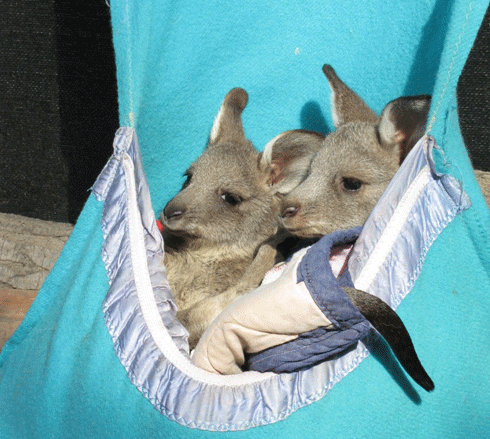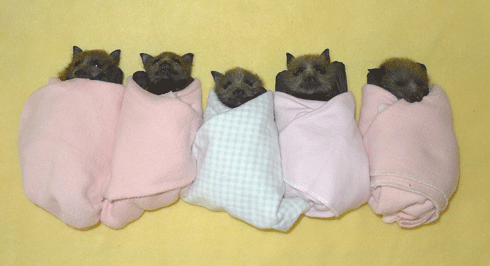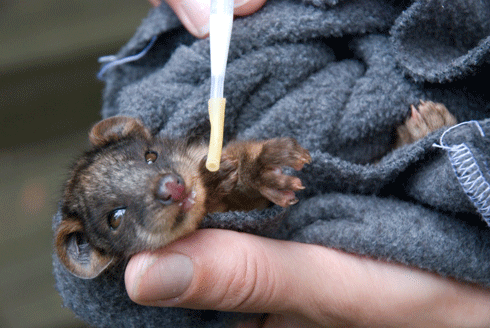
|
Published: 8 October 2012
A safer passage back to the wild
More than 30 dedicated volunteer wildlife rehabilitation networks in Australia rescue sick, injured or orphan animals and prepare them for release back to the wild. The Wildlife Information Rescue and Education Network (WIRES) in New South Wales, for example, fielded more than 100 000 emergency phone calls and rescued more than 56 000 native animals in 2010 alone.

|
|
For orphaned wild animals, one of the biggest challenges for human carers is enabling them to learn wild behaviours, including avoidance of humans and predators. Credit:
Wildlife Victoria
|
When wild animals are sick, injured or orphaned – as a result of road accidents, attacks by other animals, disease, natural disasters or human intervention – rescue, rehabilitation and release back to the wild are their only hope.
Some ill or injured animals may simply require veterinary care and a short time to recover before being released. Young orphaned animals, in contrast, also need to learn wild behaviours to enable them to survive once released.
Despite the numbers of animals involved, scientific assessments of rehabilitation are scarce. Although rehabilitation groups develop their own guidelines for care, nationally there is no clear strategic approach for Australian wildlife, and the fate of released animals remains largely unknown. Yet it is vital to identify the most effective methods that offer the greatest chances of future success.
In a recent study published in Australian Mammalogy, we took the first step towards assessing the success of rehabilitation of Australian wildlife by surveying wildlife rehabilitators about their practices.
We sent an online survey to wildlife rehabilitation centres and groups across Australia, receiving responses from people working with frogs, reptiles, birds, possums, macropods, wombats, gliders, koalas, flying foxes, bats, monotremes and various small mammal species.
Orphaned and injured wild animals are the most common type under care. Surprisingly, we found that about 20 per cent of the rescued wildlife are confiscated pets – an issue more commonly associated with developing countries, where pets such as primates and exotic birds tend to be more common.
Most rehabilitators we surveyed cited animal welfare and conservation as their most important objectives. In terms of record-keeping, most collect background information for each rescued animal, including details about what had happened to it (if known), where it was found and its diet.
Quarantining of rescued animals is common, but the period is usually less than 2 weeks. Quarantine is important to prevent disease transmission from the new arrival to existing animals at the centre or care facility. It also allows the new animal to be fully assessed prior to rehabilitation.

|
|
This echidna is lucky to have been rescued after a fire. Credit:
Wildlife Victoria
|
Our findings show that few animals are examined by a vet before release. Many rehabilitators instead rely on observations of behaviour and condition to assess health. They also indicated they would consider euthanasia in cases where a serious medical issue would make it difficult for an animal to survive in the wild – such as blindness, paralysis, loss of limbs or untreatable injuries.
Our survey revealed numerous factors that challenge the success of current wildlife rehabilitation efforts.
Negative attitudes towards rehabilitation are an issue, particularly in rural areas where some native species are considered pests. One respondent noted, ‘The most negativity we get is from farmers. They are concerned that native animals compete [with farm animals] for feed and damage fences.’
This issue is compounded in areas where government policy allows permits to be issued for the destruction of species perceived as pests.
Most rehabilitators do not conduct pre-release medical screening, putting other wildlife in the release area at risk of disease.
Although most respondents believed they were knowledgeable about the animals in their care, some were unaware of which animal behaviours are considered abnormal – such as pacing or toe sucking. Because there are no consistent guidelines for assessing animal behaviour before release, many rehabilitators still release animals that exhibit abnormal, repetitive (stereotypic) behaviours.
Some animals become habituated and show no fear of humans or domestic animals, which puts them at risk of predation after release. To increase their survival chances, rehabilitators may need to train wildlife – particularly orphaned or hand-reared animals – to avoid predators.

|
|
Rescued grey-headed flying fox pups: Orphaned animals reared with siblings or others of the same species tend to become independent more easily than those reared alone. Credit:
Wildlife Victoria
|
We asked respondents which factors they considered in assessing the suitability of release sites. These included availability of food and water, correct habitat type, predators, and proximity to roads and other human-related dangers. Fewer than 35 per cent considered all of these factors.
Many rehabilitators released animals on their own property, probably the easiest option for monitoring but not necessarily the most appropriate. Consideration also needs to be given to how many animals the area can support or whether it is the best available site for release.
After releasing animals to the wild, rehabilitators typically monitor them for only a few days or weeks – primarily because of a lack of time, money, resources, expertise and government support.
It can also be difficult to track released wildlife. Feeding stations may be used to encourage the animals to visit a certain location, but around one-tenth of rehabilitators used more sophisticated methods such as tracking devices, motion-sensing cameras and microchips.
Only about half the rehabilitators assessed the success of releases, and for most, this was based on short-term monitoring data. Although the criteria for success are sensible – such as whether the animals are healthy, independent, feed from natural sources, behave normally and breed – rigorous assessment requires long-term monitoring data.
Given our findings, we see scope for the development of best-practice guidelines for wildlife rehabilitation in Australia based on shared knowledge. We encourage scientific researchers to collaborate with wildlife volunteer networks to expand our knowledge and help improve this potentially valuable wildlife conservation practice.
Amanda Guy is a PhD candidate at the University of New South Wales. Peter Banks is an Associate Professor at the University of Sydney.
More information
Guy, AJ, Banks, P (2011) A survey of current rehabilitation practices for native mammals in eastern Australia. Australian Mammalogy 34, 108-118.




